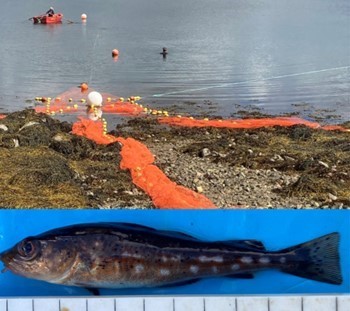Coastal fyke catches spotty cod
Posted: Monday 21 November, 2022 @ 16:21:21

Peter Cunningham and Roger McLachlan
A coastal fyke net was set up in Loch Ewe by Boor at the end of August to find out whether this sort of fish trap could be a good way to sample sea trout in the sea for sea lice monitoring purposes.
The coastal fyke is like a large floating lobster pot with long leaders (instead of bait) to guide fish into the trap. An otter guard is fitted to the entrance to prevent an otter from entering; the guard also prevents larger fish from going in.
The trap was set to fish over four days during the following two weeks. The trap was redeployed in early November to gain more experience and fished for a further three days.
Many fish were caught! Most of the fish were lightly sedated and processed (length, weight [of larger ones], photo). When all wide-awake again or near enough, they were returned to the sea - several hundred metres away from the trap to minimise the likelihood of recaptures.
The catch included six sea trout, demonstrating that the trap can work as intended. By late summer, many smaller sea trout (finnock) have returned to freshwater. With the River Ewe and Loch Maree nearby, we were not expecting to catch large numbers of trout. Were the trap to be deployed earlier in the summer, the numbers of smaller sea trout in the area would probably be much higher. So we look forward to being able to deploy the trap again in late May or early June next year.
Most of the fish recorded were juvenile gadoids of between 10cm and 17cm in length. These comprised of coalfish, cod, pollack, poor cod and several whiting. Many of these fish were infested with ‘black spot’, caused by the parasite Cryptocotyle lingua.
To gain a measure of the number of black spots on the fish close up photographs were taken of a sub-sample of fish on 4th November by Roger Mclachlan. Some of the little fish had upwards of 100 black spots, based on counts from photographs. About half of them had spots on the eye. Click here for this report with pictures of the trap, some of the fish caught and a graph showing estimates of blackspot numbers on a random sub-sample of small fish from the trap.
Projects with pictures and stories about the Boor fyke net and the parasite Cryptocotyle lingua can be found on the ispot website; please follow the following links:
We have routinely recorded black spots on sea trout. Some sea trout in Loch Gairloch have been particularly heavily infested in previous years; however so far we have not been too concerned about the affect of this parasite on the health of the trout. There is a story about Cryptocotyle lingua on trout on page 20 of the WRFT Review May 2011.
However, for small gadoids, for example cod and pollack, infestation by Cryptocotyle lingua can cause premature mortality. Kilburn et al 2005 report that juvenile cod could be killed if free-swimming infective cercaria released from the intermediate periwinkle host penetrate the brains or hearts of the cod.
Some questions:
To what extent are cod numbers (especially of larger cod) around Wester Ross affected by this parasite? Are most little cod gobbled up by seagulls or other seabirds before they get big because they are infested with black spot?
Or are there also large numbers of juvenile cod and pollack away from the shore in places where they are less exposed to infection by Cryptocotyle lingua?
Does the distribution and foraging behaviour of gulls (especially herring gulls) affect the abundance of Cryptocotyle lingua and infestation of juvenile cod? In Loch Gairloch gulls congregate around the outflow pipe of Inverkerry fish farm.
Why have populations of large cod not recovered around Wester Ross?
It’s easy to point fingers at seals or unsustainable fishing practices for cod, when in some situations there may be other factors, albeit associated with other human impacts to coastal ecosystems, that can also contribute to reduced life expectancy for cod in coastal waters.
Samples of small fish with blackspots have been sent to Marine Scotland Science marine lab to learn more.
For help with the coastal fyke net, thank you very much to Colin Simpson, Finn Simpson, Tracy Mclachlan, Peter Burk, Emma Watson, Steve Merrill, James Close and Dorje Khandro; to MOWI for permission to use the shore base at Boor; to Fisheries Management Scotland and the Crown Estate for support; and to Campbell Pert at MSS for info about blackspot.
References
Kilburn, R., C. Pert, D. Bruno & R. Raynard (2005) Parasite management important to future cod aquaculture in Scotland. Global Aquaculture Advocate https://www.globalseafood.org/advocate/parasite-management-important-to-future-cod-aquaculture-in-scotland/
Ryberg, M.P., Huwer, B., Nielsen, A., Dierking, J., Buchmann, K., Sokolova, M., et al. (2022) Parasite load of Atlantic cod Gadus morhua in the Baltic Sea assessed by the liver category method, and associations with infection density and critical condition. Fisheries Management and Ecology, 29, 88– 99. https://doi.org/10.1111/fme.12516https://onlinelibrary.wiley.com/doi/epdf/10.1111/fme.12516
A more detailed illustrated account can be found here .